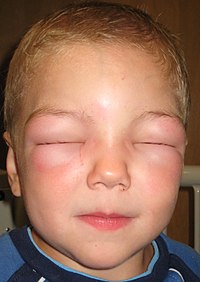Non-Histaminic Angioedema

A disorder that is characterized by the occurrence of transitory and recurrent subcutaneous and/or submucosal edemas resulting in swelling and/or abdominal pain.
Epidemiology
Prevalence is estimated at 1/100,000.
Clinical description
Two forms have been described: hereditary angioedema (HAE; 90% of cases) usually occurring in childhood or adolescence, and acquired angioedema (AAE) usually occurring after 50 years of age (see these terms). Patients present with white, circumscribed nonpruritic edemas that remain for a period of 48 to 72 hours and recur with variable frequency. The edemas may involve the digestive tract resulting in a clinical picture similar to that seen in intestinal occlusion syndrome, sometimes associated with ascites and hypovolemic shock. Laryngeal edema can be life-threatening with a risk of death of 25% in the absence of appropriate treatment. Dental procedures are a triggering factor for laryngeal edema. Edemas of the face are a risk factor for laryngeal involvement.
Etiology
Angioedema can be caused by quantitative or functional defects of the plasma protease C1 inhibitor (C1-INH encoded by the SERPING1 gene; 11q12-q13-1) or by gain-of-function mutations of coagulation factor 12 (Hageman factor; F12; 5q33-qter). Angioedema is triggered by bradykinin excess. Transmission of HAE is autosomal dominant and AAE may be associated with a lymphoproliferative syndrome or the presence of anti-C1-INH autoantibodies. It may also be a rare side effect of renin-angiotensin-aldosterone system blockers (RAAS-blocker-induced angioedema; see this term).
Diagnostic methods
Diagnosis is based on clinical findings, measurement of C4 concentrations and on quantitative and functional analysis of C1-INH. C1q levels are low in patients with AAE but are normal in patients with HAE.
Differential diagnosis
Differential diagnoses include intestinal occlusion syndrome and histamine-induced angioedema (of allergenic or nonallergenic origin) generally associated with urticaria.
Management and treatment
Management of acute attack includes administration of subcutaneous icatibant or intravenous administration of C1-INH concentrate. Tranexamic acid and danazol can be administered for long term prophylaxis. For the acquired form, management aims to treat the associated disease.
Prognosis
With proper diagnosis and treatment, prognosis for patients with HAE is good. The prognosis of AAE depends on the underlying disorder.